Wikijunior:The Elements/Rare Elements
Here all elements are listed alphabetically, together with a short description, which did not have their own chapter.
A
[edit | edit source]Actinium
[edit | edit source]

The word actinium comes from the Greek word for ray ("aktis"). It emits so much light that you can see a blue glow in the dark.
The half-life is the time it takes for half of a radioactive isotope to decay. The shorter the half-life, the more it radiates. longest-lived radium isotope 226Ra has a half-life of 1600 years, the longest-lived actinium isotope 227Ac has a half-life of 22 years. This time is long enough to make small batches of the substance. The Actinium obtained radiates very strongly. (Isotopes that only have a half-life of one second cannot be produced in large quantities.)
-
radioactive
Americium
[edit | edit source]

Americium is produced in nuclear power plants. (Few kilograms so far.) It is a radioactive and fissile element.
The longest-lived Americium isotope 243Am has a half-life of 7370 years.
-
radioactive
Astatine
[edit | edit source]
|right|This element was drawn in Dmitri Mendeleev's periodic table.]]

Astatine looks metallic. Astatine was synthesized by Dale Corson, Kenneth MacKenzie, and Emilio Gino Segrè at the University of California in 1940. In 1943 Berta Karlik and Traude Bernert discovered its natural occurrence. Greek means ἀστατέω = "to be unstable".
It is estimated that there are only 25 grams of astatine in the entire earth's crust. It is one of the rarest elements on earth.
In medicine (nuclear medicine) it is used, among other things, to treat malignant tumors. Astatine is radioactive and can be dangerous in significant amounts.
-
radioactive
B
[edit | edit source]Barium
[edit | edit source]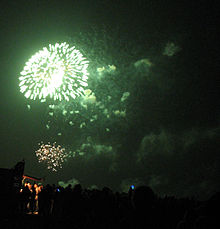
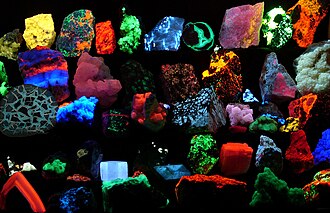
The element barium (from the Greek word for heavy) was extracted from the mineral barite. Barium containing minerals were discovered by an Italian shoemaker in 1602. This shoemaker, by the name of Vincenzo Casciarolo, studied nature alongside his work. He discovered that some stones glow after being left in the sun for a while. Water-soluble barium compounds are essential to life in small amounts and toxic in larger amounts. Barium nitrate is used for green fireworks and barium carbonate as a rat poison.
-
flammable
-
Warning
Berkelium
[edit | edit source]

Berkelium is made in nuclear reactors. It's a radioactive element.
-
radioactive
Bismuth
[edit | edit source]

Bismuth (formerly also called bismuth) was described by Paracelsus (1493-1541) and shortly afterwards by Georgius Agricola (1494-1555). Some bismuth compounds were and are used in medicine: Against the pathogen that causes gastric ulcers, against bad breath and as a wound powder and skin ointment against inflammation, to stop bleeding and other things.
With the help of bismuth one can produce an alloy that melts at 70°C (Wood's metal). It is used in sprinklers for fire extinguishing. This metal can also be used to make a teaspoon that melts in a cup of hot tea.
-
flammable
Bohrium
[edit | edit source]

This artificial element was named after Niels Bohr.
-
radioactive
Bromine
[edit | edit source]

Bromine means something like "stench" (Greek). Bromine is a liquid, orange nonmetal that emits corrosive fumes at room temperature. There are significant amounts of (harmless) bromine salt in seawater. These salts are used as plant fertilizers. Photo plates are coated with silver bromide.
-
acutely toxic
-
corrosive
-
Environment
C
[edit | edit source]Cadmium
[edit | edit source]

The word cadmium is an old word for zinc ore that was partly used in medieval and ancient times. It was made in 1817 independently by Friedrich Stromeyer and Carl Samuel Hermann from different zinc ores. It is used for solar cells, semiconductors, for nickel-cadmium batteries and also for the construction of control rods in nuclear power plants. Cadmium and cadmium compounds are highly toxic. Therefore, many applications are banned in the EU. From the 1950s, zinc mines in Japan discharged their wastewater into rivers that were used to irrigate rice paddies. The rice farmers fell ill. They experienced severe pain. Kidney failure and bone softening often led to death. Because of the severe pain, it was called "Aua-Aua disease" (Japanese "Itai-Itai disease").
-
flammable
-
acutely toxic
-
Environment
-
Health hazard
Californium
[edit | edit source]
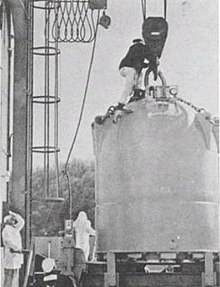
Californium is a radioactive element that is produced in nuclear reactors. The californium isotope 252Cf emits neutrons when it decays. These neutrons are used in cancer treatments, for industrial material studies, in the search for oil, in nuclear reactors and for the construction of atomic bombs.
-
radioactive
Caesium
[edit | edit source]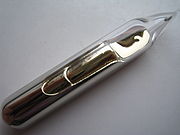

Cesium has special properties:
- It is the most reactive metal. It burns explosively when exposed to air.
- It is the softest metal.
- It is the heaviest stable alkali metal.
- It is one of the few gold colored metals.
- It has the second lowest melting point of any metal, after mercury.
- It is the "most punctual" ;-) element. Cesium is used in atomic clocks. The second is determined with cesium clocks.
Cesium was discovered in spring water in 1861 by Robert Wilhelm Bunsen and Gustav Robert Kirchhoff based on its blue spectral lines. They named the element after the Latin word for sky blue ("caesius"). Carl Setterberg was the first to produce pure cesium in 1881. Cesium is used in rocket ion engines.
-
flammable
-
corrosive
Cerium
[edit | edit source]

This element was discovered in parallel by different scientists in 1803. (Jöns Jacob Berzelius, Wilhelm von Hisinger, Martin Heinrich Klaproth). Carl Gustav Mosander produced pure cerium for the first time in 1825.
The word Cer, like the recently discovered planet Ceres, comes from the Roman goddess of agriculture and fertility, Ceres. Cerium generates sparks easily when rubbed, which can ignite smaller cerium crumbs. It is therefore used for lighters and also in films to produce an impressive shower of sparks. Iron alloys containing cerium are very ductile.
-
flammable
-
Warning
Copernicium
[edit | edit source]

Named after Nicolaus Copernicus, this element was artificially produced and researched.
-
radioactive
Chromium
[edit | edit source]Chrome is a hard, malleable metal and is lustrous silver in color.

In 1779, Louis-Nicolas Vauqueli extracted the metal chromium from the mineral crocoite.

The name chrome comes from the Greek word chrṓma (χρώμα), which means color. (The "color" of the tones, i.e. their sound, was also described in this way.)
Dyes can many dyes be made from chromium. A human body contains chromium. Most chrome ore is found in South Africa.

Chromium compounds are used in the manufacture of dyes. Commonly used: postal yellow and chrome green. Bicycle handlebars and car bumpers are coated with the silvery chrome. They look great and won't rust. Chromium is particularly important for steel production. Chrome vanadium steel does not rust and is very strong. Chromium salts are also used to tan leather.
Chromium itself is non-toxic, but some chromium compounds (e.g. the chromates) are toxic and carcinogenic.
-
Environment
Curium
[edit | edit source]

Curium is an artificial element made in nuclear reactors. It is radioactive and fissile.
This element was named after Pierre and Marie Curie. We have the two scientists to thank for many insights into the structure of our matter.
-
radioactive
D
[edit | edit source]Darmstadtium
[edit | edit source]

Darmstadtium is an artificial element that was created in Darmstadt in 1994.
-
radioactive
Dubnium
[edit | edit source]

Dubnium/Db is artificially created by shooting atomic nuclei together. There are several ways to make dubnium:
-
radioactive
Dysprosium
[edit | edit source]

This element was named after the Greek word for difficult to access (dysprósitos). This has the following reason: Dysprosium belongs to the rare earths. The rare earths react chemically in a very similar way. In nature, they are usually found mixed together. It's hard to separate them. The discoverer of this element, Paul-Émile Lecoq de Boisbaudran, found dysprosium in 1886 using spectral analysis. But he only caught the light that this element emits, he couldn't get it pure. It was only in 1906 that Georges Urbain was able to obtain the element.
-
flammable
E
[edit | edit source]Einsteinium
[edit | edit source]

Einsteinium is formed in nuclear power plants and when hydrogen bombs explode. This element was named after Albert Einstein, the developer of the theory of relativity.
-
radioactive
Erbium
[edit | edit source]
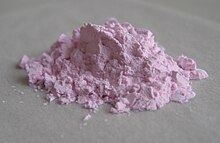
Like some other rare earths, erbium oxide is used to color glass and ceramics.
-
flammable
Europium
[edit | edit source]

Appropriately, europium is used to protect against counterfeiting in euro banknotes. It fluoresces in UV light. Europium was also used in screens and mercury vapor lamps.
-
flammable
F
[edit | edit source]Fermium
[edit | edit source]
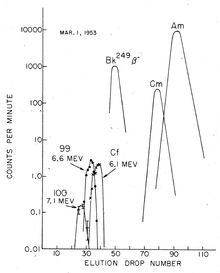
Fermium is radioactive and its isotopes have a short half-life (maximum 100 days). Fermium was created in atomic bomb explosions, in nuclear power plants, and in the laboratory.
Small atoms can be made into larger atoms by adding particles (neutrons). This process takes place in nature in stars and especially in stellar explosions (->supernova). This is how the other elements were formed from the small hydrogen atoms.
This process can be reproduced in the laboratory. Up to the element fermium, the atoms can absorb neutrons and grow larger. The heavier elements decay immediately when neutrons are added. Even heavier elements can only be produced by shooting two atomic nuclei at each other.
-
radioactive
Flerovium
[edit | edit source]
Only a few atoms of flerovium were produced. It was named after Georgi Nikolayevich Fleorov.
-
radioactive
Francium
[edit | edit source]

Francium has an electron on the outer shell and is therefore an alkali metal. Its properties can therefore be predicted, but are difficult to verify since only tiny amounts of this element exist.
-
radioactive
G
[edit | edit source]Gadolinium
[edit | edit source]

Gadolinium is a rare element. The mineral lepersonnite-(Gd) contains this element. This mineral has a complex chemical composition: Ca(Gd,Dy)2(UO2)24(SiO4)4(CO3)8(OH)24 48 H2O.
-
flammable
Gallium
[edit | edit source]

Gallium is a rare, silvery-white metal. About 100 tons of it are produced per year. It is used for the production of light emitting diodes and solar cells. Paul Émile Lecoq de Boisbaudran first produced this element in 1875. When naming it, he killed two birds with one stone: he named the fabric both after his country and after himself: both "France" (Gaul) and "Lecoq" (rooster) are called "Gallus" in Latin.
-
corrosive
-
Danger
Germanium
[edit | edit source]

The semi-metal germanium is used in the construction of transistors. In 1886, the German chemist Clemens Winkler produced germanium at the Bergakademie in Freiberg. He named it after the Latin name of his native country. Attention: Germanium powder burns.
-
flammable
H
[edit | edit source]Hafnium
[edit | edit source]

Hafnium burns with a very bright light and is used in special flash lamps. Hafnium electrodes are used for welding. Some hafnium compounds are very hard.
Hafnium is used in large quantities in nuclear reactor control rods for nuclear submarines.
-
flammable
Hassium
[edit | edit source]

Hassium is a man-made element.
-
radioactive
Holmium
[edit | edit source]

Holmium is used for high-power magnets, in lasers, and for control rods in breeder reactors.
-
flammable
I
[edit | edit source]Indium
[edit | edit source]

Indium emits light with a blue, indigo spectral line. It was discovered by Ferdinand Reich and Theodor Richter in 1863. With few known indium deposits and much indium being consumed, it is the metal that may be the first to become depleted. It is used in aircraft, nuclear power plants and transistors. The metal does not burn, the powder is combustible. Indium can cause growth disorders in embryos.
-
flammable
-
Warning
Iridium
[edit | edit source]
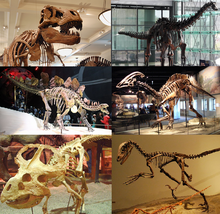
Iridium is heavy and is therefore found in the Earth's core and in some meteorites. At the end of the Cretaceous period, dinosaurs and many other creatures became extinct. The deposits of the sedimentary layer that marks the end of the Cretaceous are rich in iridium. An indication of a massive meteorite impact. The impact crater is in Mexico.
Iridium takes its name from the Greek word for rainbow (iris). It is used in alloys that need to be particularly hard, such as the ball of a ballpoint pen. It is also used in spark plugs, jewelry, as a catalyst, and in the UV coating of sunglasses.
-
flammable
-
Warning
K
[edit | edit source]Krypton
[edit | edit source]

Krypton (atomic number 26) is one of the rarest elements and could only be obtained in tiny amounts with great effort. The explorers Ramsay and Travers therefore named it after the Greek word kryptós, which means "hidden". Krypton is used in halogen lamps. Although krypton is a noble gas, it can form compounds (krypton difluoride).
Kryptonite, dangerous for Superman, is made from a made-up element called kryptonium (atomic number 126).
-
gas bottle
L
[edit | edit source]Lanthanum
[edit | edit source]

Lanthanum (Greek λανθάνειν, lanthanein, "to be hidden") was discovered in 1839 by the Swedish chemist Carl Gustav Mosander. He grew crystals from cerium nitrate in 1839. To his surprise, another crystal form formed. Another element was obviously hidden in the cerium nitrate. Mosander named it lanthanum after the Greek word for "hidden". It is used in glasses and in flints.
-
flammable
Lawrencium
[edit | edit source]

Lawrencium, named after the inventor of the cyclotron, is made by colliding atomic nuclei in a cyclotron.
-
radioactive
Livermorium
[edit | edit source]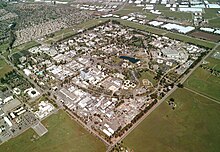
Only a few atoms of livermorium were produced. The element was named after the Lawrence Berkeley National Laboratory (LLNL) in California, USA.
-
radioactive
Lutetium
[edit | edit source]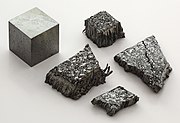

Lutetium is difficult to obtain and therefore expensive. It is not used on a large scale but mostly only for scientific experiments.
-
flammable
M
[edit | edit source]Meitnerium
[edit | edit source]

Meitnerium is a man-made element.
-
radioactive
Medelevium
[edit | edit source]

Mendelevium, named after Dmitri Ivanovich Mendeleev, is made by colliding atomic nuclei. For this, Einsteinium253Es is bombarded in a cyclotron with accelerated helium nuclei4He. This creates Mendelevium256Md and a neutron.
-
radioactive
Molybdenum
[edit | edit source]

Molybdenum was named after the Greek name for lead. Molybdenum tolerates high temperatures and is used for steel alloys. It is used as a catalyst in the petroleum industry. Many living things also use molybdenum in bio-catalysts. Some bacteria produce fertilizer from atmospheric nitrogen. For this you need molybdenum (formula Mo). (see picture) Pieces of metal do not burn, but powder burns easily.
-
flammable
Moscovium
[edit | edit source]
Only a few atoms of moscovium were produced. The element was named after the city of Moscow.
-
radioactive
N
[edit | edit source]Neodymium
[edit | edit source]

Neodymium - the "New Twin" - is one of several chemisch similar substances. Neodymium, like its twins, can be used for magnets. Neodymium powder burns.
-
flammable
-
Warning
Neptunium
[edit | edit source]
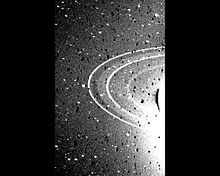
Neptunium is created in nuclear reactors and can be used as fuel in nuclear reactors and also in the construction of atomic bombs. There are about 20 different neptunium isotopes. The longest-lived isotope is 237Np with a half-life of 2.144 million years.
-
radioactive
Nihonium
[edit | edit source]
A few atoms of nihonium were artificially produced. Nihon means "Japan" (Japan) in Japanese.
After the discovery, the element was first given the systematic name ununtrium (chemical symbol Uut), a formation from Latin unum for 'one' and Latin tria for 'three', corresponding to atomic number 113. It was also called eka-thallium, composed of Sanskrit eka for 'one' and thallium, with reference to its classification in the periodic table 'a place below thallium'.
-
radioactive
Niobium
[edit | edit source]
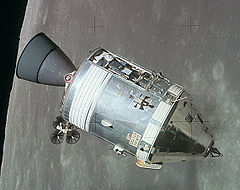
The elements niobium and tantalum always occur together in ores. This element was named after Niobe, daughter of Tantalus. This element was independently studied and given different names by two chemists: Charles Hatchett (1801) Heinrich Rose (1844). The IUPAC is responsible for naming the elements. It was not until 1950 that the name niobium was agreed upon. Niobium serves as a steel alloy and is used in jewelry and coins. Niobium does not burn, but niobium powder is combustible.
-
flammable
Nobelium
[edit | edit source]
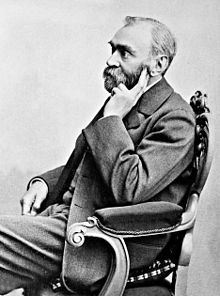
Only a few thousand atoms of the element nobelium have been produced to date.
-
radioactive
O
[edit | edit source]Oganesson
[edit | edit source]
Only a few atoms were made of the element oganesson. It was named after Yuri Zolakovich Oganesian.
-
radioactive
Osmium
[edit | edit source]

Osmium is durable, hard and heat resistant, but also quite expensive. Some artificial heart valves contain an osmium alloy. Like tungsten, it used to be used in light bulbs.
-
flammable
-
corrosive
-
Warning
P
[edit | edit source]Palladium
[edit | edit source]

Palladium was named after the recently discovered asteroid Pallas, which in turn was named after the Greek goddess Pallas Athena. William Hyde Wollaston, who gave the name, extracted the element from platinum ore in 1803. Palladium is used as a catalyst. So it destroys toxic gases in the exhaust of the car. Good white gold alloys contain palladium in addition to gold. White gold is used for coins, dental crowns and jewellery.
Amazingly, the solid metal palladium has cavities inside. Hydrogen gas can therefore flow through hot palladium sheets as if through a sieve and thus be separated from other gases. If you put a piece of palladium in a compressed gas bottle and fill it with hydrogen, the palladium absorbs the hydrogen like a sponge. One liter of palladium solutions can store three thousand liters of hydrogen. (Tank for hydrogen cars.) Chunks of palladium do not burn, but powder burns easily.
-
flammable
-
Warning
Polonium
[edit | edit source]
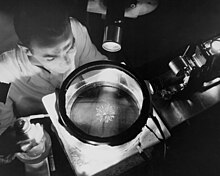
Radioactive elements turn into other, lighter elements. They emit radiation. In some mines, miners breathe in the radioactive gas radon. When radon decays, it turns into the metal polonium. Polonium can cause lung cancer. It was used as a neutron source in the atomic bombs that destroyed Hiroshima and Nagasaki.
-
radioactive
Praseodymium
[edit | edit source]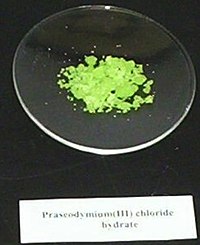

"Leek Green Twin" is the translation of the name of this element. If you look at the pictured praseodymium compound, the designation leek green (Greek: prásinos) becomes clear. But what is the meaning of the word twin (Greek: didymos)? In 1874, Per Teodor Cleve recognized that the substance obtained by Carl Gustav Mosander was two different substances that resembled each other almost like twins.
Praseodymium is used to build powerful magnets. Praseodymium powder burns.
-
flammable
Promethium
[edit | edit source]

Promethium is formed through the radioactive decay of other elements such as uranium. There is about 570g of promethium, finely distributed, all over the world. (The amount was not actually found, but only determined by calculation.) In recent decades, enough promethium has been produced in nuclear power plants that chemical experiments could be carried out with it. Promethium is a silvery heavy metal that reacts similarly to neodymium.
Some atomic bomb builders saw themselves in the role of Prometheus: they brought nuclear fire to mankind. (Read at Richard P. Feynman.)
The discoverers of this element, on the other hand, had a different intention: They named the element after Prometheus as a warning against the nuclear arms race.
-
radioactive
Protacinium
[edit | edit source]

In the mineral uranium, the element uranium decays and the element protacinium (234mPa) is formed for a short time, which quickly (half-life: 1.17 minutes) decays into actinium. This isotope was discovered by Kasimir Fajans and Oswald Helmuth Göhring in 1913. A long-lived isotope of the element protacinium (231Pa) was discovered by Otto Hahn and Lise Meitner in 1918. (Half-life: 32,760 years)
-
radioactive
R
[edit | edit source]Radium
[edit | edit source]

Radium comes from the Latin word for ray ("radius"). The element radium decays, emitting alpha rays (helium nuclei), beta rays (electrons), and gamma rays (X-rays). All elements that emit such rays are called radioactive. Radium was first used as a medicine and in cosmetics. It took several years before the dangers of radioactive radiation were recognized and almost thirty years before radium was no longer used for it. Radium was discovered by Henri Becquerel and studied in detail by Marie and Pierre Curie. (They died as a result of the radiation.)
-
radioactive
Rhenium
[edit | edit source]

Rhenium, from the Latin word for the river Rhine (rhenus), is added to alloys to improve them. Due to the high forces, turbine blades can deform (technical term: "creep") or even break (technical term: "fatigue"). Thermocouples are made from an alloy of platinum and rhenium. With them you can withstand high temperatures (up to 2200°C) measure. It is also used for heating wires and incandescent lamps.
Rhenium metal does not burn, but rhenium powder does.
-
flammable
Rhodium
[edit | edit source]

Platinum ores often contain chemically similar elements. In 1803, William Hyde Wollaston extracted rhodium from platinum ore. It is used as a catalyst and as a coating for jewelry. A thin layer of rhodium prevents metals from tarnishing and gives it a silvery sheen. Rhodium can also be used to make mirrors. Pieces of metal do not burn, but powder burns easily.
-
flammable
Roentgenium
[edit | edit source]

Roentgenium is a man-made element. It was named after Wilhelm Conrad Roentgen.
-
radioactive
Rubidium
[edit | edit source]

All atoms emit a light that is typical for them. Rubidium emits a purple-red light. Using this light, Robert Wilhelm Bunsen and Gustav Kirchhoff discovered rubidium in 1861. Bunsen then extracted 9 g of rubidium salt from 44,200 l of spring water. (The Latin word for red is "rubidus". This is also where the gemstone ruby got its name.) Rubidium is used for a few applications such as some vacuum tubes. Rubidium burns in air and explodes when quenched with water.
-
flammable
-
corrosive
Ruthenium
[edit | edit source]

Ruthenium was named by the element's discoverer, Karl Ernst Claus, after the Latin name for Russia (ruthenia). Tiny amounts of this substance improve the quality of steel alloys and protect them from rusting. Ruthenium is also used to make hard drives and as a catalyst. Pieces of metal do not burn, but powder burns easily.
-
flammable
Rutherfordium
[edit | edit source]
Rutherfordium is a man-made element that has a short half-life. It was named after Ernest Rutherford, who provided an impetus for the development of other atomic models with a simple atomic model.
-
radioactive
S
[edit | edit source]Samarium
[edit | edit source]
Samarium is extracted from the mineral samarskite. This mineral was named in 1847 after the mining engineer who discovered it. Elements were often named after Greek and Roman deities in the past. This element was the first to be named after a human.
The mineral samarskite contains uranium and has therefore been mined in significant quantities. The by-product samarium is used in lasers, magnets and as a catalyst.
-
flammable
Seaborgium
[edit | edit source]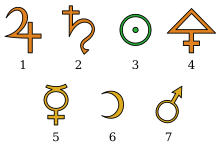
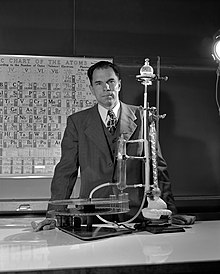
This man-made item was nach named Glenn T. Seaborg. Seaborg succeeded in producing gold atoms in 1980. The alchemists were already pursuing this goal.
-
radioactive
Selenium
[edit | edit source]

Selenium is a metalloid and comes in three forms (modifications): There is silver-grey metallic selenium, black non-metallic selenium and red non-metallic selenium. It was discovered by Jöns Jakob Berzelius in 1817. The word "selenium" comes from the Greek name of the moon "Selene". It is used for building semiconductors and for exposure meters. In small traces, selenium is essential for life, in larger amounts it is acutely poisonous. Selenium can also cause significant organ damage (liver, heart).
-
acutely toxic
-
Health hazard
Strontium
[edit | edit source]

A strontium-bearing mineral was discovered and studied by Adair Crawford in Strontian (Scotland) in 1790. Strontium salt is used in the aluminum industry and to make fireworks. It is sometimes found in anti-inflammatory toothpaste. Strontium is also used in some vacuum tubes. About 500,000 tons of strontium salt are mined every year.
Strontium fires cannot be extinguished with either water or carbon dioxide.
-
flammable
T
[edit | edit source]Tantalum
[edit | edit source]

Tantalum hardly reacts, it is largely chemically inert. Tantalum oxide does not react with water or acids. Figuratively speaking, tantalum oxide is incapable of quenching its thirst. In Greek mythology, the evil Tantalus could not quench his thirst as punishment for his misdeeds. This element was therefore named after him.
Tantalum powder burns.
-
flammable
Technetium
[edit | edit source]

This element was discovered in minerals in 1925. Technetium is the first (1937) man-made element and got its name from the Greek word for artificial (τεχνητός / technētós). In nuclear power plants, technetium forms as radioactive waste. Approximately 80 t of technetium have accumulated to date. Some of its isotopes have a half-life of around 200,000 years. In small amounts it is used in nuclear medicine.
-
radioactive
Tellurium
[edit | edit source]

Tellurium comes from the Latin word "tellus" which means earth. It was made in 1782 by Franz Joseph Müller von Reichenstein. It is used as an additive to alloys and the oxide as a glass.
-
acutely toxic
Tennessine
[edit | edit source]
Only a few atoms were made of the element tennessine. It was named after Tennessee, USA.
-
radioactive
Terbium
[edit | edit source]

Terbium is used in magnets and to dope semiconductors.
-
flammable
Thallium
[edit | edit source]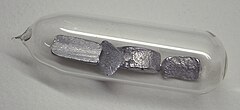

Thallium is used for lenses in photocopiers and photocells.
Thallium is highly toxic. Possible course of poisoning in humans:
2nd-3rd Day: Alternating diarrhea and constipation.
2nd week: hair loss
2nd-3rd week: blurred vision, excessive pain perception, abnormal heart rhythm, muscle weakness (can result in death) After the vPoisoning often results in permanent damage to health: disturbed reflexes, muscle atrophy. Even chronic poisoning with small amounts poses a significant health risk!
A thallium compound was previously used as a rat poison because it has a delayed effect and the rats do not realize that the baits are poisoned. (Young rats have to eat something as "tasters". If they get sick, no other rat will eat it.)
-
acutely toxic
-
Health hazard
Thorium
[edit | edit source]

Elements can have different numbers of neutrons in the nucleus. They are called isotopes. Chemically, they react in the same way, but they have different lifespans. (The half-life is how long it takes for half of the substance present to decay.) To the chemist, isotopes with a very, very long half-life are no different from normal, stable elements. You can find ores, extract them and experiment with them.
Thorium was discovered by Jöns Jakob Berzelius in 1829. It's a radioactive element. Its longest-lived isotope 232Th has a half-life of 14,050,000,000 years. Because of its long half-life, it is also found in the earth and because of its long half-life, this thorium isotope emits very little (low dose rate).
Therefore, the danger of thorium was misjudged. The harmfulness of the radioactive radiation was not recognized at first and then it took several years until the radioactive substances were no longer used in everyday goods. Thorium was used in mantles, welding electrodes, glow electrodes. Thorium glass lenses have special optical properties. Thorium dioxide was even used as an X-ray contrast medium: the contrast medium containing approx. 5g thorium was injected into the patient's veins before the X-ray was taken. Many patients developed cancer after 30-35 years. (The thorium is stored in the body. It takes 22 years for half of the stored thorium to leave the body: biological half-life.)
Thorium is also suitable for use in nuclear power plants. In the nuclear power plant, the thorium isotope 232Th is irradiated with neutrons 1n and turns into the thorium isotope 233Th. (Calculation: 232+1=233). This highly radioactive thorium isotope has a half-life of 22 minutes and decays to fissile uranium in two steps. Nuclear power plants that use thorium generate a lot of nuclear waste and facilitate the construction of nuclear bombs (technical term: proliferation).
However, it is also possible to use thorium to destroy nuclear-grade plutonium (keyword: MOX fuel element).
-
radioactive
Thulium
[edit | edit source]

Thulium is named after the island of Thule. This island was discovered far to the north in ancient times and later associated with many myths.
Thulium is used in dosimeters to measure radioactive emissions. It is also used in scintillators and lasers.
-
flammable
-
Warning
X
[edit | edit source]Xenon
[edit | edit source]

Xenon can be used as a fill gas in lamps to increase the life of the tungsten filaments and also the luminous efficacy. There is also an application in headlights, which, in contrast to incandescent lamps, have a higher light output with lower energy requirements. Xenon is used in excimer lasers.
-
gas bottle
Ytterbium
[edit | edit source]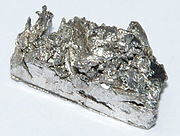

Ytterbium is used in specialty steel, lasers, and magnets. The best permanent magnets contain ytterbium.
-
flammable
-
Warning
Y
[edit | edit source]Yttrium
[edit | edit source]

In 1794, Johan Gadolin found an ore in the Ytterby mine in Sweden, from which yttrium was extracted. In 1824, Friedrich Wöhler extracted the element yttrium from it. Yttrium is one of the rare earths (which are not that rare). It is used for magnets, fuel cells and spark plugs. Yttrium powder can build up in the lungs and damage them. Pieces of metal do not burn, but powder burns easily.
-
flammable
-
Danger
Z
[edit | edit source]Zirconium
[edit | edit source]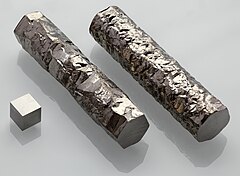

The zircon gemstone can have many colors due to the addition of other elements: colourless, red, yellow, green, blue, brown or black. This gemstone has been used since ancient times. It can easily be confused with the diamond and is sometimes sold by scammers as a "real" diamond. Experts can easily tell them apart, as zircon is not nearly as hard as diamond. Zirconium is used for steel alloys and in nuclear power plants. Pieces of metal do not burn, but powder burns easily.
-
flammable

















